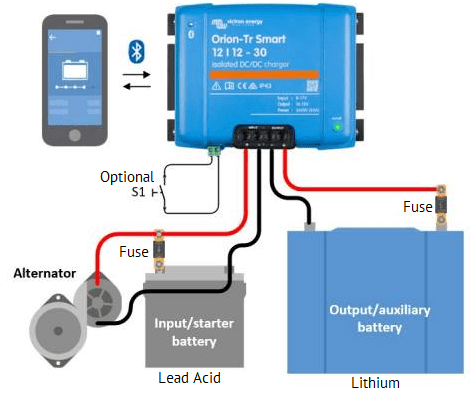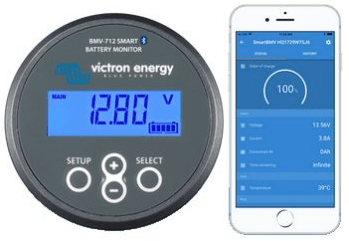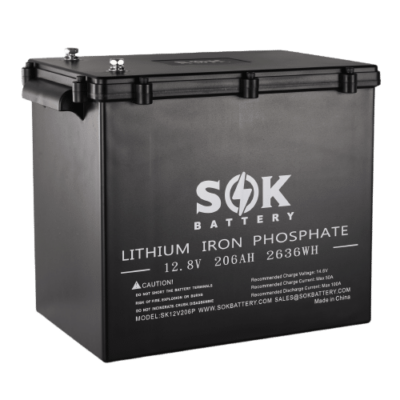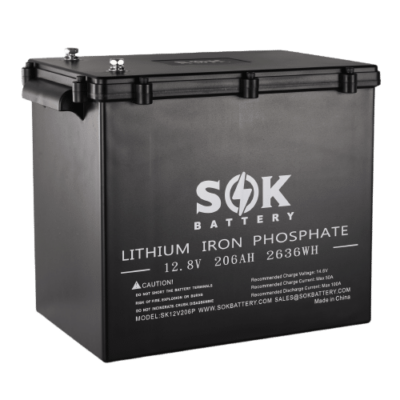Phone 09 871 0505
How to convert from lead to lithium.
How to convert from lead to lithium.
If you’re looking for a dependable and long-lasting battery for your recreational vehicle or off-grid solar system, consider converting to Lithium Iron Phosphate (LiFePO4) batteries. These batteries offer a host of advantages over traditional lead-acid batteries.
Safety Advantages of Lithium Iron Phosphate (LIFePO4): An Excellent Choice for Solar Energy Systems
When it comes to applications where safety is a top concern, manufacturers across industries are turning to Lithium Iron Phosphate (LiFePO4) batteries. LiFePO4 batteries are known for their excellent thermal and chemical stability, which makes them the ideal choice for high-risk applications. The LiFePO4 battery remains cool in higher temperatures and is incombustible in the event of rapid charges, discharges, or short circuit issues. Unlike traditional lithium-ion batteries, LiFePO4 batteries do not experience thermal runaway, as the phosphate cathode remains cool and does not burn or explode during overcharging or overheating.
In comparison, the high energy density of traditional lithium-ion batteries can cause instability and lead to thermal runaway. When overcharged or overheated, the lithium-ion battery heats up faster and can become a safety hazard.
Another key advantage of LiFePO4 batteries is the ease of disposal after use or failure. Lithium-ion batteries made with a lithium cobalt dioxide chemistry are considered hazardous materials and can cause serious medical issues if ingested. They also require special disposal considerations due to the risk of allergic reactions to the eyes and skin when exposed. In contrast, LiFePO4 batteries are non-toxic and can be disposed of more easily.
LiFePO4 batteries offer numerous safety advantages over traditional lithium-ion batteries making them the perfect choice for users seeking a safe, reliable, and long-lasting power source for their motorhomes, RVs or off-grid.
Why replace lead batteries with LiFePO4
Lead vs. LiFePO4: Depth of Discharge
Depth of Discharge, or DoD, is how much of your battery bank’s stored energy can actually be used without dramatically reducing its life. For example, a 100Ah (amp hour) lead acid battery rated for 25% DoD means you need to plan to use only ¼ of its rated capacity (so 25Ah), leaving the other ¾ in the battery, unused.
DoD for lead acid batteries – both flooded (which you have to add water to periodically) and sealed (“maintenance-free”) – is typically in the 25% – 50% range. Your battery will last at least twice as long if you regularly discharge it 25% than if you regularly discharge it 50%. Keep in mind that if you don’t have a sunny day to recharge your batteries after a day of use, the DoD will go down again the next day – so planning to use 25% per day will allow you to use less than the 50% maximum after two days of use.
On the other hand, DoD for LiFePo4 batteries is 80% or more, allowing you to use most or even all of the battery’s stored energy. That means a 100Ah lithium battery rated for 80% DoD can safely provide you with 80Ah without being harmed.
As a result, a lithium battery bank can be much smaller than a lead acid battery bank to provide the same amount of usable energy. For example, if you need 100Ah of energy a day, you would need a 400Ah lead acid battery bank to stay at 25% DoD, but would only need 125Ah of lithium at 80% DoD. That is a significantly smaller battery bank with lithium batteries.
Lead vs. LiFePO4: Cycle Count
Cycling a battery means discharging it to any amount and recharging it to a fully charged state. If you cycle your battery bank every day for a year, that’s 365 cycles. If you only use it on the weekends, and keep the bank topped off the rest of the time, that’s 104 cycles a year.
A cycle is a cycle regardless of how deep the discharge is, but the depth of discharge directly affects how many cycles you can expect your battery to last. A battery’s specs will tell you how many cycles to expect from it when discharging to its rated DoD.
A standard flooded lead acid battery can have about 2500 cycles at 25% DoD
A standard sealed lead acid battery can have about 1200 cycles at 25% DoD
A good quality lithium iron phosphate battery can have 4000 + cycles at up to 100% DoD.
Lead vs. LiFePO4: Charge/Discharge Rate
In addition to how much of a battery’s capacity you use, it also matters how fast you use it. Again using the 100Ah battery example, if you have a 10 amp (A) load, that can drain the battery completely in 10 hours (100Ah ÷ 10A = 10 hours). That is considered a C/10 rate. Likewise, if you have a 50A load on the same battery, that would drain it in 2 hours (100Ah ÷ 50A = 2 hours). That is a C/2 rate. Most batteries are rated at their C/20 rate, emptying the battery in 20 hours.
If you have a high-current load in your system, or are charging it very quickly with a high current, such as your alternator or shore power, you need to consider the charge/discharge rate of the battery bank. If you need a higher rate than the batteries can handle, you would need to increase the battery bank by adding more batteries in parallel so that the batteries can share the current between themselves. This may result in needing a battery bank that has a higher Ah capacity than you need to power your loads, just to handle the high current.
Likewise, too slow of a charge of lead acid batteries can cause premature sulphation, shortening their life. This is not a problem with lithium.
Lead acid batteries tend to perform best between C/8 and C/12 rates. So our 100Ah battery would want to be charged or discharged at between 8A and 12A. Wiring three batteries in parallel would permit three times the rate, as it shares the current between the three, so 24A to 36A.
Some lithium batteries can generally handle a C/1 rate, or even higher for short periods depending on the battery. This means a 100Ah lithium battery can handle 100A (or more) of charge/discharge current. Most manufacturers recommend no more than a C/2 rate on a regular basis for best battery life, but it is good to know the extra power is there with lithium batteries if you need it.
You may be familiar with the voltage of your boat or RV’s battery bank sagging, or dropping to 11V or lower when trying to run a high-power load such as your winch, windlass, or air conditioner. When running a heavy AC load off the inverter, the voltage could drop below the low voltage cutoff, causing the inverter to turn off when you need it most. Likewise, if you are running a DC load like a pump directly off the battery bank, you need it to maintain a high enough voltage for it to work when you really need it to work. Due to lithium batteries’ voltage curve and ability to handle high current, loads like these will not cause the voltage to drop dramatically, eliminating the problem of voltage sag.
Lead vs. LiFePO4: Size and Weight
With a higher DoD, higher cycle count, and higher charge/discharge rate, it’s easy to see how using lithium batteries in your RV or boat saves space by requiring a physically smaller battery bank…and I don’t need to explain the advantages of saving space in an already tight spot. But there’s yet another physical benefit of replacing lead acid batteries with lithium for RV and marine applications: Lithium batteries also don’t have the crazy weight from being made with lead! Lighter weight means higher fuel efficiency, saving you additional money in gas or diesel costs.
Lead vs. LiFePO4: Safety
Safety is always a primary consideration when designing a solar system. Different battery chemistries have different risk factors. Obviously, abusing any type of battery can create a dangerous situation. But with normal, and perhaps even a bit of rough treatment, the different batteries have different safety concerns that need to be addressed.
Flooded lead acid batteries have an acid and water electrolyte in the battery that has to be checked on a regular basis. During normal charging cycles, this mixture turns into a gas that needs to be vented outside. A buildup of the gas inside a vehicle or vessel can be explosive. Proper ventilation mitigates this concern. The outgassing of the battery is normal, but requires owners to regularly check to see when the electrolyte level gets low from the outgassing. If low, it needs to have more distilled water added. This runs the risk of acid spills if overfilled or overcharged. This requires you to be prepared with proper safety equipment including gloves, safety glasses, and baking soda to neutralize the acid if needed.
Sealed lead acid batteries do not have outgassing or electrolyte levels to check, as they do not outgas. Normal battery safety measures should be followed, like checking for tight cable connections, corrosion, and preventing physical damage to the battery itself.
Lithium batteries also do not outgas, but certain types (the ones with cobalt, known as lithium cobalt oxide or LCO) can experience thermal runaway – a condition where the battery starts to get hot, which causes it to react to the heat and get hotter and hotter until it catches on fire. LCO batteries are most commonly used in cell phones, hoverboards, and electric cars, and are generally not recommended for mobile applications.
So are LiFePO4 batteries any safer than other batteries? Yes – when they don’t contain cobalt. Lithium iron phosphate (LFP or LiFePO4) chemistry has become the standard lithium battery for marine, RV, and general solar PV use because they have no thermal runaway issues. They are very safe, can be installed indoors, and are a perfect solution for mobile living, recreation and off-grid. Just as with sealed lead acid batteries, making sure the cables haven’t shaken loose with vibration from travel, and a visual inspection to ensure all is well is all that is needed.
Lead vs. LiFePO4: Lifetime Cost
If you compare lithium batteries to lead acid batteries Ah to Ah, lithium batteries cost more, but step back and look at the bigger picture – taking into account everything we’ve covered so far – and you can see how lithium batteries can actually save you money, time, and hassle in the long run.
By choosing lithium batteries as a lead acid battery alternative, you will need fewer batteries, and those batteries will last longer, cycle deeper, deliver more power, and weigh less.
Considerations when replacing lead batteries with LiFePO4.
Now that you’re convinced lithium is the best way to go, you need to be aware of a few things when replacing a lead acid battery with lithium. The term “drop-in replacement” has become popular, but the reality is there are a few other things you’ll need to do to safely upgrade from lead acid to lithium batteries in your boat or RV.
Charge Controller/Charging Profile
If you are currently charging your lead acid batteries with solar, your alternator, and/or shore power, you may be able to keep your existing charge controller or inverter/charger. The charging and low voltage cutoff profiles for LiFePO4 batteries are a little different from lead acid, so you need chargers that have adjustable charge rates. Different batteries will have different preferences, so be sure to see the manufacturer’s recommendations when configuring your charger. Because LiFePO4 has a very narrow voltage window, 12V is generally the lowest voltage you want before you shut off your loads.
Note: Unlike lead acid batteries, LiFePO4 batteries do not always need to be recharged to their full 100% capacity. They actually prefer being in a partial state of charge. If you are going to be leaving your boat or RV for a season of storage, it is recommended that you leave the battery bank at around 90% state of charge. This leaves plenty of energy for small loads like the bilge pump or CO2 alarm, but helps maintain a healthy battery bank until you can get back to normal use.
Solar Charge Controller
The solar charge controller controls the flow of energy that is collected by the solar panels before it hits the batteries. There are two types of solar charge controllers: Pulse Width Modulation (PWM) controllers and Maximum Power Point Tracking (MPPT) controllers. We recommend MPPT controllers such as the Victron Smart Solar MPPT Charge Controller 100/30. Simply put, MPPT is a superior technology that will make the most of the solar panels you have while minimising losses. Learn about choosing the correct size MPPT solar charge controller here.
Cranking Amps / Starter Battery
With lead acid batteries, we are used to seeing a rating of CCA (cold crank amps) to show how many amps can be used to start an engine in the cold weather. Lithium batteries do not have the CCA rating. If you intend to replace a lead acid battery with LiFePO4 for your starting battery, make sure the new lithium battery is rated to handle enough current to do so. Not all of them are. We see a lot of people continue to use a lead acid battery as the starter, with lithium used only for the house/service battery. This also gives you a bit of a backup, so that if everything goes wrong with your house/service battery, you still have the starter battery available.
Alternator
Unlike lead acid batteries, LiFePO4 batteries have very little internal resistance and can take as much charging current from the alternator as needed, but since alternators are not designed to run at full speed for long periods, this can result in the alternator working too hard, overheating, and damaging itself. There are a few ways to prevent this from happening.
Use a DC/DC Converter
By installing a DC-to-DC converter between the alternator and the LiFePO4 battery bank, you can limit the amount of current the battery draws from the alternator. It is recommended that you only draw from the alternator at half its rating, so for a 60A alternator, a 30A DC/DC converter like the Bluetooth-enabled Victron Energy Orion-Tr Smart 12/12-30A charger is a good option. You can use multiple DC/DC converters in parallel to increase the rate for larger alternators.

Replace the Alternator
You can replace the alternator with one designed for higher amperage charging and temperature control. Balmar makes great alternators and external regulators for this. They monitor the temperature and will wind down to appropriate amperage if the alternator gets too hot. If you currently have a V-belt, you may need to modify the engine for a serpentine belt before you can use the larger Balmar alternator.
Battery/Bank Monitoring
The Victron Energy BMV-700 or the Victron Smart Battery Monitor BVM-712 (with Bluetooth) gives you a local display for convenient viewing of battery voltage, current, power, amp-hours consumed, and state of charge (SoC). A battery monitor is highly recommended as it provides a way to manage your battery use (including the ability to set low battery alarms) For multiple battery installs a Battery Monitor provides a global view with out having to connect to each individual batteries Bluetooth function.

Why Choose SOK?
Reliable and Trustworthy Performance
Superior Build Quality
Longer Lifespan
Genuine Grade A+ LiFePO4 Cells
Quality Battery Managment Systems
Manufacturer Backed Warranties and Technical Assistance
We back our products
All SOK batteries have manufacturer backed warranties. If if there is an issue with your battery we’ll get it resolved in a timely maner.
Technical query? Drop us a line and our team of experts will help.
Free Delivery
Convieniently buy online and choose either tracked free delivery via PBT or Main Freight or choose to pick up from our Auckland warehouse.






